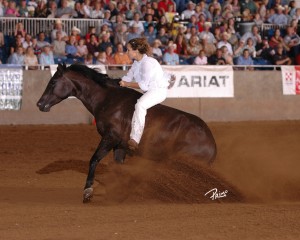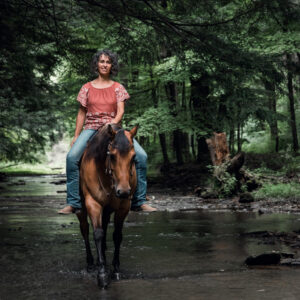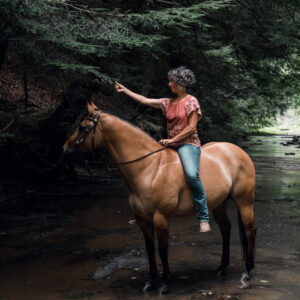
Look closely, my toes are up!
It is November, which means you are likely to see “No Stirrup November” showing up as a theme.
While I appreciate the concept, I’d like to propose a twist.
But before that, let us pause and consider what the point of No Stirrup November is; for riders to improve their seat and legs.
If you’re not accustom to riding without stirrups, there is a good chance that dropping them for your entire ride could actually work against this goal. Great riders have an independent seat, which means their seat stays with the horse, and they can move their legs ‘independently’.
If you participate in No Stirrups and notice:
- your legs want to draw up your horse’s sides and contract
- your breathing becoming shallow
- or you have a desire to lean forward
Remember, these are signs that you are getting more tense.
This is not the path forward towards developing an independent seat/leg combination.
Additionally, forcing yourself to ride longer in this position is also hard on your horse.
Here is my twist on No Stirrups November.
Rather than making ‘no stirrups’ the goal, let’s instead focus on something that will require you to have an independent leg.
Here is how:
- While riding in your saddle at a walk, practice taking only one foot out of one stirrup, for example, your left foot.
- Ride a few steps and then practice putting that foot back into the stirrup without disrupting your horse’s walk rhythm.
- Repeat, this time dropping the right stirrup, and replacing it.
This version of ‘No Stirrups’ has many benefits.
- Because you are only dropping one stirrup at a time, you are less likely to begin overcompensating; gripping with your legs, or tightening elsewhere.
- The looseness required to replace your foot in the stirrup without disturbing your horses’ rhythm, will naturally increase your awareness of both your seat AND your independent legs.
- By alternating from the left stirrup, to the right stirrup and back, you are also more likely to notice any imbalances you may have.
The long-term benefits of this practice are compounding.
- Riders who can easily ‘drop’ and regain their stirrups again are less likely to over use the stirrups for balance. Over-use results in tension and dependance.
- Riders who can do this exercise easily are more likely to keep the balls of their feet properly placed in the stirrups, which promotes proper leg position and placement.
‘Proper’ leg position isn’t just for those with saddles. Take a closer look at the famous ‘Live Like You Were Dyin’ photo or video, and you’ll see…my toes up, heels down…with no stirrups.
Here are photos from a trail ride photo shoot. Notice in this photo, where I am in motion, that my toes are up, and my heels are down. I’m not doing this for proper foot placement in my stirrup, this position lengthens my leg along the horse’s sides.

When actively riding, my toes come up, heels go down, creating a long leg for better balance and communication with my horse.
Notice in this photo where I’m taking a closer look at this tree, I’m no longer actively riding. You’ll see my toes have dropped because while standing still and distracted. It’s actually work to hold my toes up without stirrups.

Not actively riding, my toes drop. Notice the vertical alignment and long leg.
By training myself to ride in this position, with or without the saddle, I have a long leg that naturally hangs below my hip, independent of my seat. This long leg acts as a counterweight to my upper body, increasing my balance.
The awareness needed to develop this position is the same awareness that allows me to communicate clearly with my horses through leg cues alone.
If you like my twist, you can still follow the rest of the No Stirrup November rules. Track your rides, count the number of days you participate, and in this case, you could even count the number of times you drop and regain your stirrups.
Happy No Stirrups November (with a twist)!
Ride with Faith,
Stacy Westfall
2 Comments
Leave a Comment

FREE PDF DOWNLOAD
WHY IS MY HORSE...?
100% Private - 0% Spam
No one taught you the skills you need to work through these things.
Riders often encounter self-doubt, fear, anxiety, frustration, and other challenging emotions at the barn. The emotions coursing through your body can add clarity, or can make your cues indistinguishable for your horse.
Learning these skills and begin communicating clearly with your horse.
Click here to learn more.

Interesting article. I have an instructor in Arizona who believes in the no stirrup approach all the time. I actually feel like I have not control and we worked up to a trot with no stirrups. But it is so easy to let your toes go up and out and just chill on the saddle instead of actively riding. She was also a big proponent of starting a riding session with no stirrups and then moving to the stirrups and to also know how to pick up your stirrups if you drop them, which honestly was harder than it looks. She did let me use stirrups with a canter. I have to say, when I got off the horse at the end of the lesson my legs were sore, but my seat was improved.
I ride my FAT, very round Peruvian Paso bareback most of the time! I like his cadence and he is a very well-behaved horse. I am cognizant of my toes up and relax into my tailbone… otherwise I will roll right off the side!
Thank you for all your advice!
Keep it hoof side down! Karen